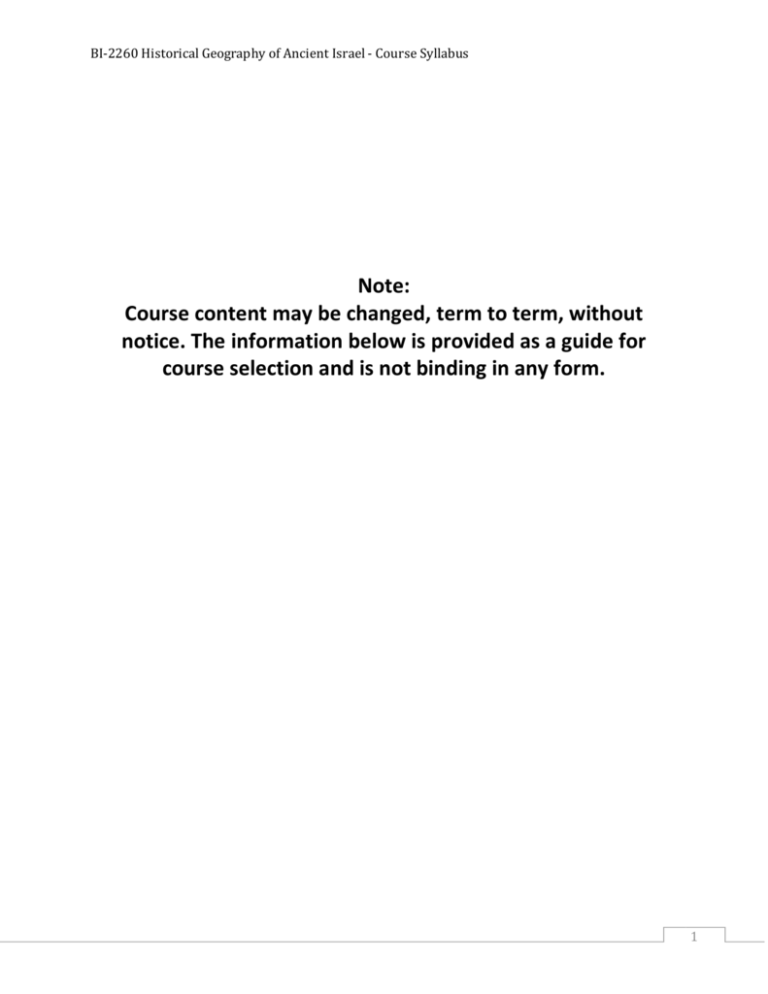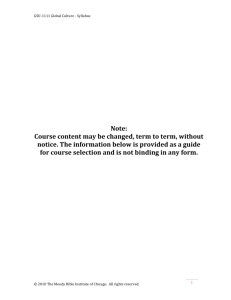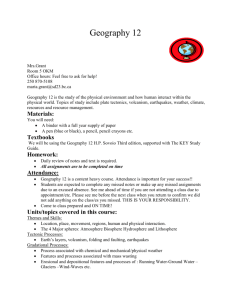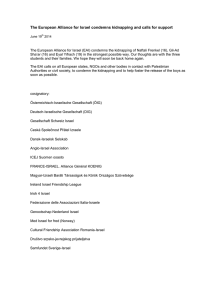
BI-2260 Historical Geography of Ancient Israel - Course Syllabus
Note:
Course content may be changed, term to term, without
notice. The information below is provided as a guide for
course selection and is not binding in any form.
1
BI-2260 Historical Geography of Ancient Israel - Course Syllabus
MOODY DISTANCE LEARNING
Course Number, Name, and Credit Hours
BI-2260 Historical Geography of Ancient Israel, 3 credit hours
Course Description
This course is a survey of the principal physical features of the land of Israel, and a review of the
historical geography of Israel for all the important periods in the Old and New Testaments, with attention
to the relationship between Israel's geography and her history.
Course Objectives
By the completion of this course students should be able to:
1. Identify the major mountains, rivers, valleys, and other prominent geographical features in Israel
and locate them on a map
2. State the major characteristics of all the regions of the land and arrange those areas
geographically
3. Identify the major cities throughout Israel’s history, and relate the historical importance of those
key sites to the historical development of Israel
4. Evaluate selected problems in the Bible where geography plays an important role and explain
the relationship between geography and any proposed solution to the problem
Course Textbook(s) and/or Supplemental Information
Required textbooks for all Moody Online classes can be found on the Required Textbooks section of the
Moody website.
Assignments
Class Participation: Active participation is expected in this online course. Participation includes two
main areas: discussion boards and reading.
a. Discussion Boards: You must maintain a significant presence in the discussion board. Students
must make an initial post that indicates a familiarity with the assigned text(s) and critical thought
on the subject and the question at hand. This initial post is due each week by Friday, 11:59 pm
CT. Students must make two additional posts on fellow student’s postings by Monday, 11:59 pm.
b. Reading Course Expectations: The completion of the course reading, online articles, etc. is an
important part of the course. You are expected to complete the weekly reading assignments prior
to your discussion boards each week so you are able to discuss the concepts with others in the
course. Because of the wide breadth of geographical matters we will cover in this course, it is
crucial for students to remain current in their reading. There are three (3) specific types of
required reading assignments.
Class Notes: For the first three (3) lessons an online set of Class Notes will be posted.
They will be accompanied by video presentations within Google Earth. For the final five
(5) lessons the Google Earth videos and textbook reading will replace the Class Notes.
Textbook: The New Moody Bible Atlas is intended to help complement the Class Notes
for the first three (3) lessons and then to serve as your primary textbook for the final five
2
BI-2260 Historical Geography of Ancient Israel - Course Syllabus
(5) lessons. For each lesson, specific sections will be assigned that are designed to give
you insight into the geographical regions—or historical periods—being covered.
Online videos and other materials: There will be at least one (1) online video each lesson
to help introduce the material being presented in the Class Notes and specific
assignments for that lesson. In addition, there will be videos for the course included in
the Google Earth.kmz files.
Paper Assignments: Five (5) 500-750 word papers are required for this course. These assignments
should be completed in double-spaced, MLA format unless specifically noted. You will be using The New
Moody Bible Atlas and the Bible to complete these papers.
Paper #1
Submit a 500-750 word paper on the following: Using The New Moody Bible Atlas (p. 123), study
carefully the map showing division of the land among the tribes then note the buffer between the
rival tribes of Judah and Ephraim. Trace the history of their rivalry in the provided passages.
.
In light of these passages respond to the following questions in your paper:
1. Why do you think Benjamin and Dan were assigned the land between Judah and
Ephraim?
2. Why was the first king of Israel from the tribe of Benjamin?
Paper #2
The purpose for this study is to help you evaluate the specific historical and geographical means
God used to enrich David and Solomon.
Submit a 500-750 word paper on the following: Using your textbook, read 2 Samuel 8:1-18 and
note the kingdoms and cities subdued by David. Then read 1 Kings and identify the various
sources of income for Solomon. What are the different means used by God to enrich David and
Solomon?
Paper #3
Submit a 500-750 word paper on the following topic: Using your textbook, trace the Assyrian
invasions of Israel in 2 Kings. In a section dealing with the rising threat posed by Assyria, why did
the biblical writer stop to record the attack by the kings of Aram (Syria) and Israel against
King Ahaz of Judah (2 Kings 16:5-6)? In light of these verses, how would you interpret Isaiah 9:17?
Paper #4
Submit a 500-750 word paper on the following topic: Look at The New Moody Atlas map of
Jerusalem (p. 221) as you read Nehemiah. Do you think Nehemiah rebuilt the entire city of
Jerusalem, or just the smaller portion on the eastern side? On what facts do you base your
conclusions?
3
BI-2260 Historical Geography of Ancient Israel - Course Syllabus
Paper #5
Submit a 500-750 word paper on the following issue: Look at The New Moody Atlas map (p. 244245) and read Matthew 8:28-34; Mark 5:1-20; and Luke 8:26-39. Harmonize these passages and
identify where you believe this miracle took place, paying particular attention to the details in the
text. Defend your answer.
Major Course Project: The purpose of this project is to provide a more critical and extended study of a
particular area of historical geography that you will study independent of other assignments or course
progression. It is to show research and understanding of historical geography as it applies to biblical
writings, events, history, or location.
Select one (1) of the following project options:
A. Choose a particular geographical area of the Bible and trace the historical incidents that occurred
in that area. Include maps and diagrams to illustrate the history.
B. Choose a particular city in Israel and trace its history. Show how its geographical location
influenced its historical development. Include any maps and charts that can illustrate that history.
C. Take any book of the Bible and study its geographical imagery. Explain the historical basis for
each image and the point of reference taken by the author.
D. Take a particular period of biblical history and explain geographically what was taking place
during that period.
Assessments
Your grade for this course will consist of:
Class Participation:
Discussion Boards – 15%
Reading Reports – 10%
Paper Assignments
Major Course Project
25%
40%
35%
100%
Letter grades are determined by the following scale:
Letter
Grade
A
AB+
B
BC+
Percentage
Equivalent
96% or higher
90 - 95.9%
97 - 89.9%
83 - 86.9%
80 - 82.9%
77 - 79.9%
Letter
Grade
C
CD+
D
DF
Percentage
Equivalent
73 - 76.9%
70 - 72.9%
67 - 69.9%
63- 66.9%
60 - 62.9%
Below 60%
Course Copyright Statement
Copyright © 2015 by The Moody Bible Institute of Chicago. All rights reserved.
Unless otherwise specified, the materials and services on this website are for your personal and noncommercial use, and you may not modify, copy, distribute, transmit, display, perform, reproduce, publish,
license, create derivative works from, transfer, or sell any information, software, products or services
4
BI-2260 Historical Geography of Ancient Israel - Course Syllabus
obtained from the website without the written permission from Moody Distance Learning, Moody Bible
Institute, 820 N. LaSalle Blvd., Chicago, Illinois 60610.
ADA Compliance Statement
Moody Bible Institute complies with the ADA (Americans with Disabilities Act) as well as Section 504 of
the Rehabilitation Act, by providing appropriate accommodations to qualified students with
disabilities. We value diversity and inclusion and recognize disability as an aspect of diversity. Our
shared goal is to create learning environments that are accessible, equitable, and inclusive. If you
anticipate barriers related to the format, requirements, or assessment of this course, you are invited to
address the professor with your concerns; additionally, you are encouraged to contact Gayla Gates, our
disability services provider, at the Student Resource Center to discuss possible environmental
modifications or adaptations. Please note, accommodations are not retroactive, therefore we encourage
you to contact our service provider within the first two weeks of the semester. Contact Gayla Gates at
ggates@moody.edu or 312-329-2177.
5







